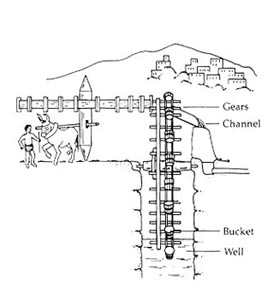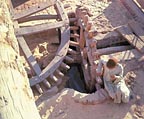The History of Water Pumping - Part 3
This installment takes a look at the 2,200-year-old saqiya.
Until quite recently, one of the perennial problems of life in the Middle East was the lifting of water from rivers and wells for irrigation. Near the Nile and other large rivers, annual floods naturally watered a thin strip of land along sloping banks. Using a seed drill known as a seluka, the inhabitants of the Nile valley were able to farm the inundated areas. But these narrow bands of fertility, often only a few yards wide, could not sustain even a sparse population. Hence, in ancient times, numerous irrigation methods were developed to extend cultivation.
During the Hellenistic era (333-30 B.C.), two new pumping devices were developed. One of them was the cylindrical Archimedean screw, which saved labor but also could not irrigate much more than an acre (See the February issue of National Driller). The other was the saqiya.
Although some history books record the saqiya as the Persian waterwheel, and its origins have been linked with Mesopotamia, its principal area of use was and is the Nile Valley. Conducting a survey in the rural northern region of the Sudan, I was able to find only a handful of the 11,000 wheels registered there 40 years ago. But seeing these few was like unearthing a lost world; they were exactly like those known by the Ptolemies so many centuries ago.

|
| A schematic drawing of a saqiya |
In its oldest and simplest form, the saqiya consists of a huge wooden wheel with wooden cogs on its outer rim, a similar but smaller wheel, and a large open-spoked wheel with a wide, open periphery. The large wheel is fastened onto a vertical wooden axle. An arm is mounted on the upper part of this shaft, so that the wheel can be turned by a cow, a pair of donkeys or even a camel. Some of the bigger wheels require a pair of bulls or water buffaloes. Usually a seat is attached to the arm so that a small child can sit and drive the animals. As the larger wheel is turned, the smaller wheel, which is mounted on a horizontal axle, is driven as a gear. This second axle runs under the platform on which the saqiya is erected so that it does not interfere with the circular path of the draft animals. On the end of the horizontal axle opposite the smaller wheel is the open-spoked wheel on which large earthenware jars known as zears or qadus are attached. If the river level is high, these jars may be lashed directly onto the wheel. On the other hand, if the water is low, the jars may be tied to two parallel loops of rope that are jointed together by spacing bars. This rig works like a pulley; the jars fill as they drop into the water and the endless ropes go around the bottom of their reach. When they are lifted over the open-spoked wheel, they spill the water through the open periphery into a trough that leads to the field channels.
Music of the Saqiya
No description of the saqiya would be complete without relating the sounds that emanate from the device. The mechanism itself has a creaking groan that is repeated over and over as the draft animal makes its way around the large wheel. Accompanying this rhythm are the evenly spaced rushes of water as the jars pour out their contents and the shuffling and bellowing of the animal. To the visitor, the repetition of these sounds all day and sometimes into the night can be dismaying. But for the local farming communities, it is music bringing a reassurance that all is well.
Saqiyas such as these are able to raise water from 6 feet to 40 feet and deeper, depending on the adjustment of the parallel pulley ropes. During the late winter flood season along the Nile, when a lift of only about 6 feet is needed, a single saqiya can irrigate a little more than 5 acres. Even at low river, when the weather is also at its hottest, an acre and a half of field crops or a date palm grove of several acres can be watered with virtually no human effort. This basic kind of saqiya is completely made of locally obtainable materials - wood, earthen jars, rope made of twisted palm trunk fiber, and sometimes leather thongs. Although in some places nails are used and gasoline cans have replaced the zears (earthenware jars), no metal is necessary. Repairs can be made by local craftsmen, and the device often is operated by children. No fuel, lubricant or sophisticated technical knowledge is required. It was this Hellenistic type of saqiya that opened up large areas along the Sudanese Nile for settlement. The saqiya can make the peasant's small holding a totally self-contained economic unit. For centuries, farmers along the Nile have relied on saqiya irrigation and animal husbandry for their livelihoods.

|
| A modern design of a 2,000-year-old invention. |
However, the Hellenistic-style saqiya does have its drawbacks. Mechanically, it is inefficient; much power is lost in friction. Often water that has just been lifted is blown back into the river by the wind. The ropes need to be lengthened as the river ebbs; unusually low water may leave fields stranded. Using wheels in series, a practice known as kalatod, is rarely profitable. Also, siltation may cut off the water supply, so digging or moving to a new site may be necessary. A great deal of the irrigated crop goes to feed the draft animals. However, the very fact that a small farmer has field crops and animals that provide meat, milk, leather, transportation and labor makes rural communities more self-sufficient and confident. Furthermore, the introduction of more “modern” methods such as electric pumps, tractors and fertilizers has led to the displacement of traditional farmers and increased unemployment - without a corresponding rise in productivity per acre.
The Saqiya's Evolution
In the last two millennia, the saqiya has seen numerous changes in design and use. These developments have been particularly evident in lower Egypt, where improvements have been made along several lines. One of the first was the development of the well saqiya, or matara, which enabled farmers to irrigate areas away from the Nile. Friction was reduced first with animal fat lubricants and later with bearings. Designs were standardized. Screens were erected to minimize wind disruption. Ropes, containers and troughs were altered. Finally, an extremely efficient but expensive and virtually immovable iron saqiya with bevel gears, chains and galvanized buckets was invented.

|
| From a quarter of the big wheel rim, we can calculate that there must have been 48 cogs in total. |
A blossoming of saqiya use has occurred since dams and barrages were built across the Egyptian section of the Nile to control water flow. By the middle of the 20th century, water levels were stabilized and lifting requirements were lessened. For the first time in history, permanently anchoring a saqiya became feasible. The actual function of the device also changed - it no longer lifted from the river itself but merely raised water a meter or two from a public channel leading from a dam and sent it onto individual holdings. The taboot, a metal-sided wheel with containers built into its rim, has become common along the canals. These wheels can be driven by steam or diesel engines or, in a few rare areas, by the force of the river itself. However, animals have remained the primary motive power.
Perhaps the most fundamental change in the saqiya has happened in the last two decades. The latest wheel, or saqiya gideed (new saqiya), is shaped roughly like a star and has metal gears. Water is scooped up at the points and flows to an axle in the center, where it is discharged into a trough at a high rate. Although the new saqiya can lift only about one meter, it can irrigate 10 or more acres. Like its Hellenistic ancestor, it requires only animal power but, unlike its predecessor, it must have a firm foundation in concrete because it is meant to be permanent.
Today, thousands of saqiyas line the banks of Egypt's irrigation canals. The stabilization of water levels, first by barrages and recently by the ecologically controversial Aswan High Dam, has given new life to this ancient technology. Paradoxically, in Egypt's poorer southern neighbor, the Sudan, saqiya irrigation has ceased to be significant. Farmers were encouraged to buy diesel-powered pumps, either cooperatively or individually. Consequently, saqiyas were dismantled and craft animals were sold off, and an age-old way of life vanished. Village elders lamented the loss of the saqiyas' “music,” but they were told that progress must have its way. But the oil price increases of the 1970s bankrupted most of the Sudanese farms - both private and cooperative. Thus, agriculture in Africa's largest and potentially richest nation was ruined. Famine, petroleum shortages, unrest and an unplayable foreign debt resulted. Of course, the abandonment of the saqiya is by no means the only cause of these problems; but one cannot help thinking that the self-reliance of saqiya irrigation and all that goes with it could have done much to stem this decline.
Egypt has gone the route of appropriate technology, and food is grown for the country's dense population with minimal expenditure on imported energy. From Aswan to the Delta, tens of thousands of saqiyas bear witness to a technological continuum, while in the Sudan, where few changes have been made to the Hellenistic original, only a few diehards persist with their wheels. On a 2-mile hike along a typical public irrigation channel in the Nile Delta, I was able to see more saqiyas and taboots in use than I found during four years in the Sudan. Of course, given the right policies and projects, reforms could alter the situation in the Sudan. At a number of universities and research institutions, studies continue in this area of alternative engineering. The best gears and bearings can assure that the “music” will never return to the river. However, prosperity and stability need not elude the rural communities that line the banks of the Nile. Clearly, new developments in saqiya irrigation will be forthcoming. The wheel that has served its masters so well for more than 2,000 years will not be retired as a curiosity, of interest only to historians, archaeologists and museum-goers. In a world conscious of the expense and limitations of fossil fuels, the future of the saqiya seems brighter than ever.
Looking for a reprint of this article?
From high-res PDFs to custom plaques, order your copy today!

